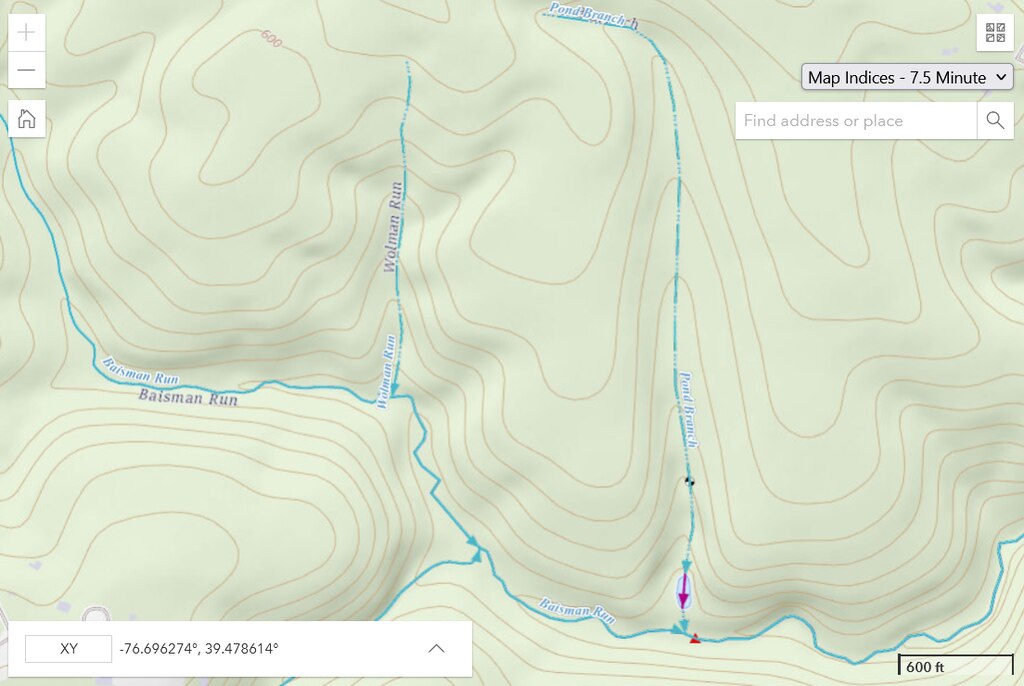M. Gordon “Reds” Wolman would have loved his birthday present.
The legendary Johns Hopkins geomorphologist, who studied rivers and streams in Baltimore County until his death in 2010, now has one named for him.
Wolman would have turned 100 this week. His namesake stream, Wolman Run, is quite a bit younger. It was dedicated in the summer of 2018 after an intense lobbying effort that included letters from senators and members of Congress, the blessing of the county parks department and County Councilman Wade Kach, and official word from the U.S. Geological Survey.
“There’s a pretty high bar to getting a natural feature named after someone,” said Andrew Miller, one of Wolman’s former students and a geology professor at the University of Maryland, Baltimore County. “But Reds clearly met and exceeded that bar.”
The Baltimore Banner thanks its sponsors. Become one.
Wolman was both a fixture at Hopkins and in Chesapeake Bay policy-making circles. He was a fluvial geomorphologist, meaning he studied rivers and how they flow and change the contours of the landscape. The Harvard-educated Wolman came by his fascination with water honestly. His father was Abel Wolman, a sanitary engineer who helped establish the practice of chlorinating water and is responsible for saving thousands of lives in the early part of the century.

The younger Wolman sought quantitative measurements as well as policy changes when he could prove they would help water quality. He came up with the “Wolman pebble count,” a method of determining the size of the sediment in a waterway by counting its rocks. He was also responsible for the “Wolman curve,” which explains how fast and how frequent sediment travels. One of his frequent collaborators was Luna Leopold, son of the great naturalist Aldo Leopold.
In the 1960s, Wolman developed some of the earliest research on how construction projects were choking streams with sediment and runoff. That work led to major changes in the law and helped Maryland develop some of the strongest water protection laws in the nation. Many of the current stormwater laws have their roots in research he did.
Wolman went beyond his river work in the policy realm. In the 1990s, Wolman chaired the influential Oyster Roundtable, which was tasked with devising a plan to restore the Chesapeake Bay’s signature shellfish after years of disease and overharvesting. It was contentious, difficult work, and yet the affable engineer in the bow tie and suspenders was able to make progress and keep everyone talking.
Later, he chaired an advisory committee at the Maryland Department of the Environment to sound the alarm that, despite the state’s many rivers and the Baltimore area’s reservoirs, Maryland could face a serious water shortage if it didn’t keep development in check. The report became known as the Wolman Report, though its official title was “Water for Maryland’s Future: What We Must Do Today.” Released in 2008, the report’s urgency did not translate into action despite its title.
The Baltimore Banner thanks its sponsors. Become one.
Wolman was equally at home among the professors at the Hopkins Club or in a van full of sweaty graduate students returning from wading into a stream in the woods of Baltimore County. He loved studying the Baisman Run area, Miller said, because so many parts of the watershed were pristine due to Oregon Ridge. And yet, development from Hunt Valley could send sediment into the stream, which Wolman and his students could measure.

The stream named for the man known for his shock of red hair that eventually turned gray is not particularly easy to reach. It’s located about a half-mile southwest of Oregon Pond in Oregon Ridge Park, surrounded on two sides by steep slopes and verdant ferns. It’s only one-third of a mile long, and muddy in parts, with fallen tree branches crossing its shallow banks.
Within this suburban watershed, Wolman inspired generations of students and mentees to continue in careers that focused on rivers and sediment. Jack Schmidt became chief of of the U.S. Geological Survey’s Grand Canyon Monitoring and Research Center, focusing on the health of one of the American West’s most important rivers, the Colorado. Robert Summers, who collaborated with Wolman many times over the years, served as the secretary of the Maryland Department of the Environment. And Robert Hirsch was chief hydrologist for the U.S. Geological Survey for more than a decade.

Like Miller, who has chaired many scientific communities and been active in local government, many of Wolman’s former students found ways to fuse science and policy. Wolman believed in giving back to the communities. He also believed in plain language to convey ideas that could spur action.
In June, Miller organized a group of former students to visit the stream, and he may do that in future years. It’s unlikely the park will affix a sign to the stream, though “Wolman Run” now shows up on Google Maps and other online services.
The Baltimore Banner thanks its sponsors. Become one.

Sign or not, Miller is glad to have a place to reflect on all that Wolman taught him over his own long career; he’ll retire in January after almost 40 years at UMBC.
“I learned very early not to have respect for people who think they’re better than anyone else because Reds never took that attitude at all,” Miller said. “For a brilliant man, he was just so completely down to earth.”




Comments
Welcome to The Banner's subscriber-only commenting community. Please review our community guidelines.